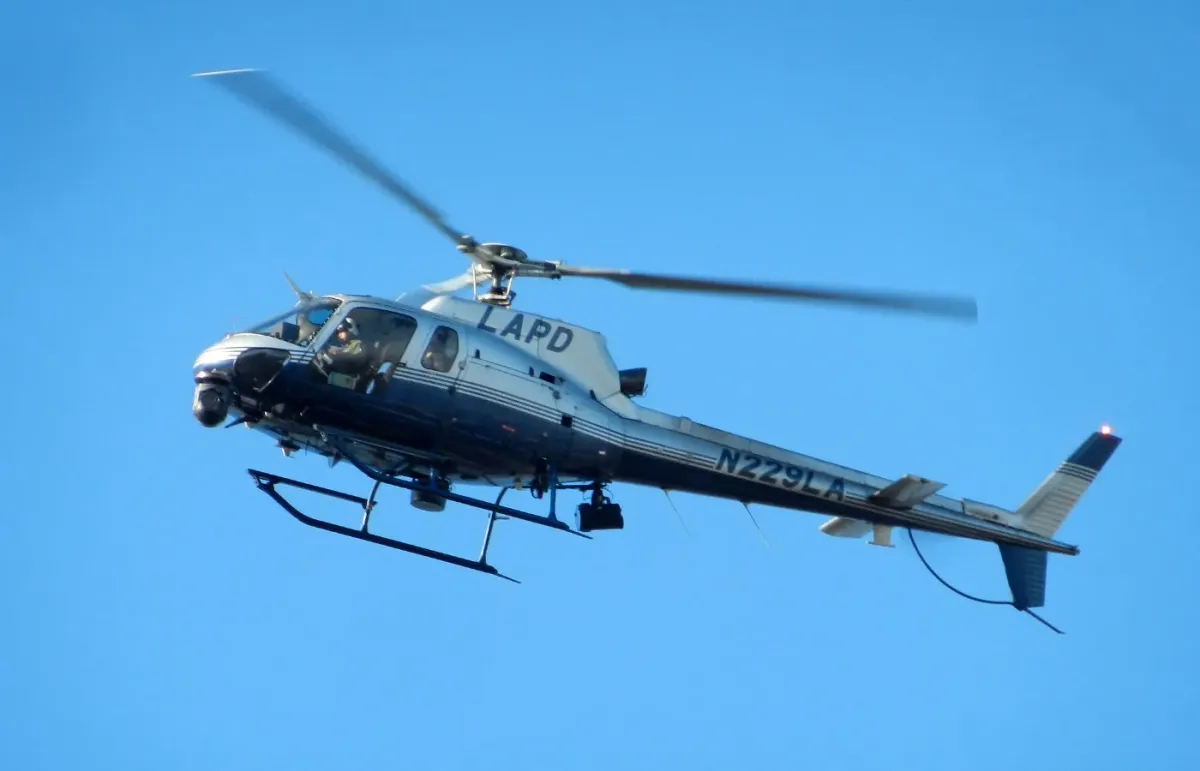
In Los Angeles, police helicopters are not reserved for emergencies, but are a routine part of police surveillance.
In South Los Angeles’s Leimert Park neighborhood, Louisa and Veronique — a teacher and self-employed jeweler, respectively — endure the daily presence of low-flying police helicopters patrolling their neighborhood.
“Afternoon, evening, at night,” Louisa tells me. “There’s no rhyme or reason to it, really.”
Angelenos from all areas know police helicopters are a fact of life. In LA, helicopters are not reserved for emergencies but are a routine part of police surveillance — as commonplace as a traffic cop patrolling the highway. According to the official LAPD website, Los Angeles has the largest municipal police helicopter operation in the world, and maintaining this massive fleet is not cheap. While recent data is hard to come by, in 2012 alone the LAPD Air Support Division cost the city $19 million. At the time, the cost per hour of operating helicopters — when factoring in personnel, fuel, and maintenance — was $1,056 per hour. By 2020, the cost of helicopter fleet maintenance alone was $23 million.

In light of COVID-19 regulations, Veronique operates her jewelry studio mostly outdoors where she has a workshop in her garden. The presence of police helicopters frequently interrupts conversations with clients and even inhibits her own ability to concentrate when working alone.
“Sometimes, I could be having customers coming to my workshop,” she tells me. “And we’re having this noise that’s really, really present. It’s not that it’s far away. It’s like if something was happening in the garden. It’s very, very noisy. It can disrupt conversation. I have this noise constantly in my ears. Even for me, to do my design, to create my work. I don’t really want to have this noise in my ears constantly. It’s really uncomfortable.”
While helicopters are a frequent occurrence in all parts of the city, they seem to disproportionately target neighborhoods with large minority populations. In Leimert Park, nearly 80% of the population is Black.
I ask Veronique and Louisa how often — by their estimate — helicopters patrol their neighborhood.
“At least once a day,” Louisa says. “Maybe multiple times a day.”
“You can really see them clearly,” Veronique adds. “I come out of the workshop and they’re not far.”
“You can see the logos on the side of the helicopter,” Louisa says.
Beyond the obvious noise pollution, Louisa and Veronique both also endure an emotional toll due to constant surveillance.
“I’m from Europe,” Veronique tells me. “Whenever there’s a helicopter, there’s suspicion of a crime. Or a bad accident has happened. But it’s every day. It’s overwhelming in terms of noise, and the whole atmosphere it creates.” She sounded tired, and continued, “It’s the same story. It’s a Black area, a neighborhood. We need to be policed.”
“It’s like a criminalization of our neighborhood,” Louisa says. “It doesn’t feel good to feel like I’m being watched by the police. They’re just surveying us, and for what? What are you going to do with the metrics?”
Police Surveillance in LA: Racism In, Racism Out
I spoke to Hamid Khan, the campaign coordinator of Stop LAPD Spying Coalition, about Los Angeles’s municipal helicopter operation.
“The LAPD was one of the first police departments in the country to deploy an aerial fleet,” he told me. “They’ve been used several pivotal moments in the city’s history, including helping apprehend protestors during the Rodney King riots and as recently as the uprisings last year.”
According to the LAPD Air Support Division website, the LAPD’s airborne law enforcement program began with a single helicopter in 1956. The website claims a study commissioned by NASA and conducted by the Jet Propulsion Laboratory’s Space Technology Applications Office found helicopter patrol is effective. The study supposedly confirmed helicopters reduce property crime, increase arrests, and that the majority of Los Angeles citizens “accept helicopter patrols as a necessary part of the City’s police system and strongly favor their continuation.” There are no citations on the LAPD Airport page on where to find or read this study they refer to in support of these claims, although KPCC reported that the only study they were able to find with LAPD and Jet Propulsion Laboratory was done in the late 1960s.
However, there is also ample reason to be skeptical of any claims LAPD makes about data-backed research. Khan tells me the LAPD has traditionally relied on data collection methods that are far from impartial.
“Biased data yields biased outcomes,” he says. “Racism in, racism out.”
He directs me to a 2018 report issued by the Stop LAPD Spying Coalition, Before The Bullet Hits The Body, that details the various weak points in LAPD’s methods of data collection and analysis.
The LAPD’s interest in predictive policing — a science that uses algorithms to make predictions about future crimes — began around 2010. For nearly a decade, they relied on two predictive policing programs: PredPol and Operation LASER (Los Angeles Strategic Extraction and Restoration).
Neither PredPol nor LASER were initially designed for domestic use. Both were born out of the early 2000s War on Terror. PredPol is a direct descendent of military-funded university research based on statistics from the Iraq insurgency. LASER draws on technology provided by Palantir, a big data company that mines government and corporate databases for signs of terrorist activity. The CIA was among the company’s first clients, and Palantir has since penned contracts with the Department of Defense, the FBI, the NSA, and ICE.
PredPol used the time and location of historical crime data to create 500-by-500 square foot areas called “hot spots.” LASER analyzed the locations of reported crime and arrest data and used it to create LASERZones, which were subjected to increased police surveillance for nine to 12 months.
“When you look at the mapping of the communities and deeming communities as anchor zones and laser points and hotspots and various things,” Khan tells me, “it’s a pseudoscientific way of deciding where the crime triggers are. It circles back to the same communities, so we have to really, really look at it as an occupying army with helicopters and drones as part of their air force.”
The data behind PredPol and LASER is hardly collected from a random sample. Myriad statistics show BIPOC communities are targeted by police at disproportionate rates, so predictive policing largely draws conclusions based on circular reasoning.
It goes beyond hard facts, however; the underlying theories driving PredPol and LASER are shaky. PredPol co-founder and anthropology professor Jeff Brantingham has published numerous papers arguing criminals are inherently foragers. In his words, “Choosing what car to steal is like choosing which animal to hunt.” Brantingham’s “forager theory” has been widely criticized in anthropology circles for failing to account for the complexities of human behavior, and yet his ideas influence real world police activity.
There are more valid theoretical debates to have, however. Before The Bullet Hits The Body touches on sociological research by Paddy Hillyard and Steve Tombs, who assert crime and criminality are fictitious in nature. Before crime can exist, a selection process determines which acts are and are not permissible. This is, of course, a very brief summary of an incredibly complex idea, but I bring it up to illustrate a point. The socially constructed nature of crime makes me think of the LAPD’s proud proclamation that helicopters reduce property crime and increase arrests — as if it goes without saying this is a net good for the community. Property crime is a vast umbrella term that encompasses numerous acts I would hardly deem a threat to public safety.
What is, however, inarguably damaging is the psychological toll constant surveillance takes on citizens.
“It’s very traumatic,” Khan says. “The knowledge of an eye in the sky, and constantly being seen. It is definitely very disruptive and traumatic to people.”
LASER was dismantled in April of 2019 due to community organizing in opposition to the program. PredPol was stopped the following year, in April of 2020. The LAPD claimed this was due to budget cutbacks, although it was more likely the result of ongoing public backlash and the fact — by then — PredPol’s effectiveness had been widely discredited.
LAPD now relies on a program called Data-Informed, Community-Focused Policing. Like LASER, it relies on Palantir data to identify crime hot spots throughout the city, but actually expands the parameters of police surveillance. LASER only surveilled those arrested for violent offenses. Under Data-Informed, Community-Focused Policing, those suspected or convicted of nonviolent property crimes are also fair game for increased surveillance.
I asked Khan what he thought the future held in terms of police surveillance, especially in light of disturbing technological advances like facial recognition software.
“What the future holds is what the past has taught,” he told me. “More and more, the facade of pseudoscience is being employed to mask deep institutional and structural racism. This isn’t a moment in time, but a continuation of history.”
What Is The End Game?
Thinking back to Louisa’s question, the truth is we don’t know what the LAPD is doing with their metrics. Palantir has never been transparent about what goes into their algorithms, and the LAPD has released very little information besides their brief summary of the single study justifying their aerial fleet.
Over the years, the LAPD has been increasingly opaque about the subject of helicopters. According to a 2007 study conducted by the US Department of Justice, the LAPD flew three times as many helicopters per hour as the NYPD and operated roughly as many helicopters as all law enforcement agencies in Texas combined.
As of 2021, we don’t have precise numbers, but the LAPD’s aerial fleet remains disruptive to many communities. Given the LAPD has offered only sparse evidence for effectiveness, it is unclear whether the benefit is worth the expenditure — especially as it comes at the expense of community well-being, as evident by Louisa and Veronique’s experience. A few days after we spoke, Louisa sent me an email:
“For me, police helicopters are a part of a much larger conversation about policing in Black and brown communities. The constant surveillance (intended or not) further criminalizes communities of color. It’s state-funded racial profiling. It’s also intrusive. It disregards the targeted community’s right to privacy. These tactics treat communities of color as possible suspects instead of citizens. And it does little to foster a sense of trust between the community and the police. I question the end game, too. If the goal of these tactics is to prevent and deter crime, has the usage of police helicopters been successful in doing that? I doubt it.”
